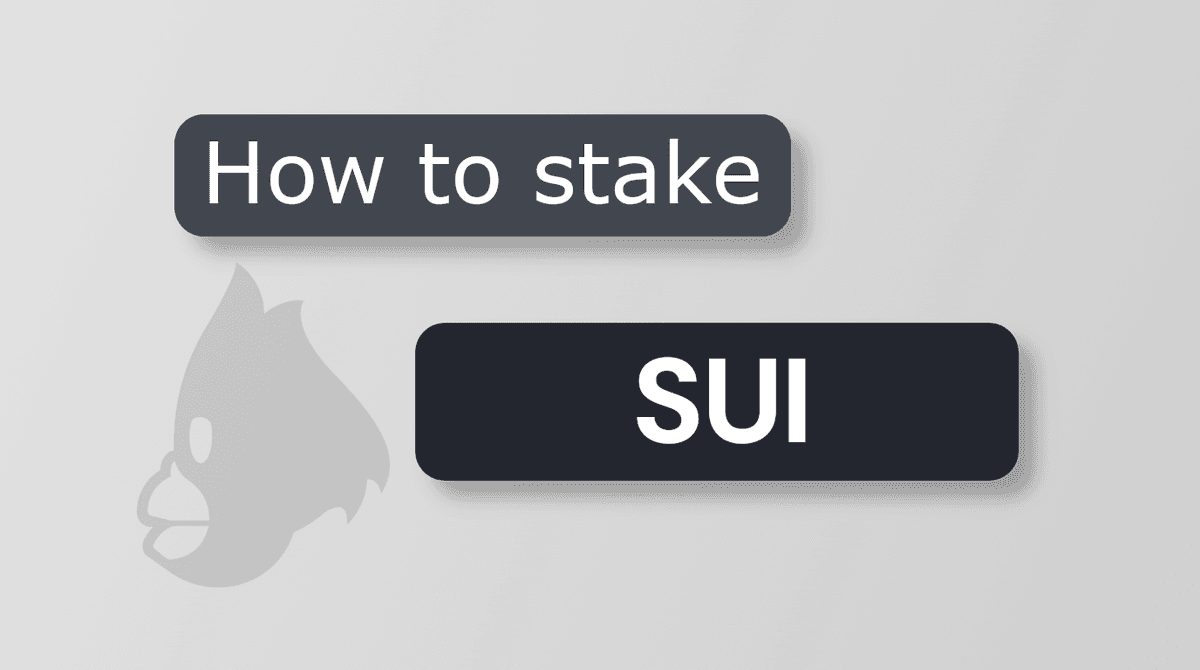Key Takeaways
- Rapid Growth: Sui's ecosystem has grown significantly since its May 2023 launch, with over $900 million in TVL (September 2024).
- DeFi, Gaming, and NFTs: Hundreds of projects span DeFi, gaming, and NFT applications, showcasing its broad appeal.
- Sui Wallet: Offers multiple wallets, including a native one for easy staking and interaction with apps.
- Real-World Use Cases: Sui is gaining traction in gaming and DeFi, with low fees and innovative features like zkLogin and object-oriented data models.
This is the third article in our series on the Sui blockchain project. If you have not read the previous articles, we highly recommend you to take a look at Sui - Explainer and From Code to Consensus: Next-Level Tech Innovations of SUI Blockchain for a complete picture.
Introduction
May 2023 marked an important moment in the blockchain universe with the launch of the Sui network. Starting even before the launch, the project attracted a lot of attention from developers and as a result, just four days after, on May 7, 2023, the first record total value (TVL) of $36 million was achieved. Currently (September 2024) the TVL is over $900 million, indicating that there are a variety of assets locked in various DeFi protocols on the Sui network.
The Sui ecosystem currently has hundreds projects demonstrating the platform's appeal for DeFi, gaming, NFT and other applications. As we dive into the Sui ecosystem, we will take a comprehensive look at different aspects of the ecosystem.
Brief intro
For those who are not familiar with the Sui project and haven't read our previous articles, let's take a quick look at the features of this project.
Launched in May 2023, by the innovative minds at Mysten Labs, Sui demonstrates an object-oriented data model that fundamentally changes the norms of blockchain architecture. This model allows for seamless parallelization of transactions, increasing scalability and reducing complexity. In a landscape dominated by giants like Ethereum and Solana, Sui holds its ground, promising a convenient experience and a dynamic ecosystem.
Diving deeper, Sui's Move programming language takes center stage. It's not just a language, it's a paradigm shift. By treating everything as an object, Move simplifies the development of smart contracts while providing security and flexibility. Its unique consensus mechanism, combining DAG and Byzantine consistency, puts Sui in the league of high-performance blockchain solutions.
Sui's economy relies on DPos (Delegeted-Proof-of-Stake) consensus and the SUI token. Beyond transactions, it fuels smart contracts, guides governance, and incentivizes validators with staking rewards.
Since interactions on the Sui network are closely tied to the SUI token, let's explore where and how to store tokens, exchange them, and profit from token staking.
Sui natively brings together leading-edge scalability solutions and user-friendly features into one robust, accessible platform for the future of decentralized applications. The unique consensus mechanism, Mysticeti, reduces the finality time of a transaction to deliver fast network responses even in conditions of heavy congestion. Scaling further, Pilotfish allows validator nodes to distribute their load on any number of machines for easy horizontal scaling.
Focusing heavily on the user experience, Sui implemented features such as zkLogin, which allows users to manage accounts securely using familiar web credentials, and zkSend, making it easier to transfer value through shareable links or via QR code. Sui removes the barriers to entry by allowing sponsored transactions and Enoki blockchain solution, thus enabling both individuals and enterprises to participate in the Web3 ecosystem.
Where to hold SUI
There are already a variety of different wallets in Sui's ecosystem with unique features that can be utilized depending on the user's goals.

To immerse yourself in the Sui ecosystem, you can use one of the 15 wallets featured in the Sui Directory, each of which goes beyond basic token storage. These wallets offer a variety of functionality, from NFT minting, token staking, to exploring and interacting with decentralized applications.
For example, Multi-sig wallet Surf allows setting team approvals for building shared treasury ownership. Users are able to interact with NFT and all popular applications through simple authorization without the need for seed-phrases. In turn, Ethos Wallet as a browser extension, goes beyond its competitors by supporting NFT browsing, built-in applications that can be interacted without leaving its boundaries. In addition, Ethos recently has integrated ZK Login, which allows easy authorization via Web2 services. Or you can choose the popular multi-currency wallet Bitget (formerly BitKeep), with over 12 million users worldwide, operating 90+ blockchain networks and 20,000+ applications with NFT support and asset exchange capabilities, as well as being available in over 15 languages.
You can select any wallet that suits your interests and goals, and here we will review native Sui Wallet from Mysten Labs team with a little guide of wallet registration and staking features.
Review Sui Slush Wallet
Sui Slush Wallet makes it easy for you to:
- Create and use multiple Sui accounts (addresses)
- Receive, exchange and transfer digital assets
- Browse your assets, tokens, and NFTs
- Track your transaction history in Sui Explorer
- Receive additional profits from staking
- Interact with DeFi, GameFi and other applications
- Import private keys from other wallets
We have chosen this wallet as a basic and simple to understand functionality. Let's start with a quick installation and creation of a new wallet.
The Sui Slush Wallet is available in two main forms: as a browser extension and as a web application. The extension is designed for Chrome and can be found in the Chrome Web Store. For more direct access, the web app version allows wallet use from any compatible web browser without an installation.
In our example we will use the browser extension. So open the link and then click "Add to Chrome".

After installing the extension, the interface will show a welcome wallet window and options for registration. You can choose between simple account registration using Facebook or Twitch, or, by clicking on the "More Options" button, you can get options for connecting to Ledger, creating a new wallet or importing an existing wallet (using a seed-phrase or private key).

Today we will consider the basic creation of an account without connection to third-party services. To do this, click "More Options" and "Create a Passphrase Account".
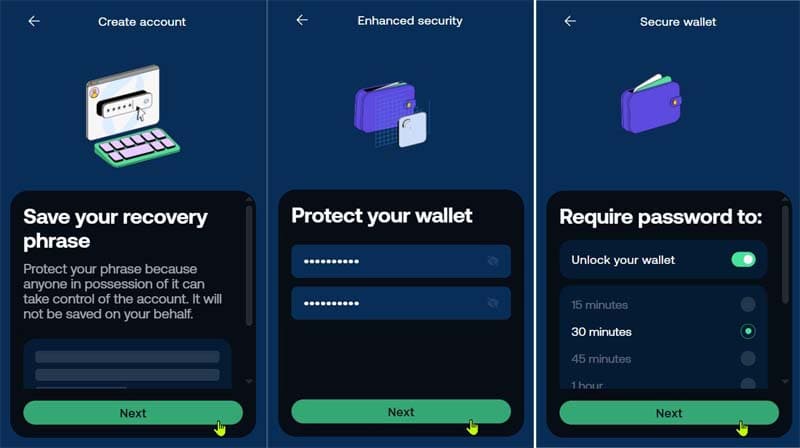
On the Wallet Setup Page you will need to set up a strong and secure password, then confirm it, activate Auto-lock for inactive period, if needed.
After the "wallet successfully created" confirmation appears, the account's security credentials can be accessed. The path to them is through the wallet address, which opens a "Manage Accounts" window containing the functions for exporting the Recovery Passphrase or Private key.

This is a really important thing! In case you lose access to the established wallet, you will be able to restore access to your assets using this seed-phrase.
In the main wallet window you will see your Account, Wallet address and SUI balance, as well as a panel at the bottom with tabs "Total Portfolio", "Invest to Earn", "Assets", "Apps", “Transaction History”, “Current Account”. The wallet allows you to create and edit multiple accounts as well, this can be convenient for interacting with different types of apps.
For balance deposit, you can either transfer SUI tokens from another account or buy them with your card.
How to buy SUI tokens
When you decide to buy SUI in the wallet, you'll start at your main portfolio screen. Here, you will find the "Buy/Sell" button that begins the process. On the next screen, you can enter the amount of money you'd like to spend.

On this same screen, you'll notice a flag icon in the top right corner. This icon is used to open a full list of countries where you can select your region, which helps the app find payment providers available to you. Finally, you'll be presented with a checkout screen that lists these providers, showing you exactly how much SUI you will receive from each one.
Besides simply holding the tokens, you are able to earn passive income trough staking. Now that you have purchased SUI tokens, let's let them work for you.
How to Stake SUI
The SUI staking is a wise move that offers benefits such as generating passive income, contributing to the security of the network, influencing the direction of the Sui ecosystem through voting. It's not just about rewards, but about actively participating in shaping Sui's future and supporting a sustainable approach to blockchain technology.
In order to stake, make sure you have SUI tokens in your account.
Then in your wallet click the "Invest to earn” button and scroll down to “Start native staking” option.

You'll get a list of all validators in the Sui network, which can be sorted by different parameters for easy search. Find and Select the validator with the nickname "Coinage x DAIC"
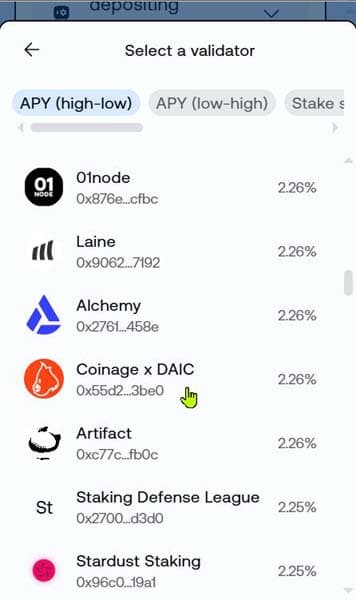
At the next step, you will see all the information about the selected validator: Annual Percentage Yield, percentage of stake share, total amount of delegated tokens. By experience, the more stakes a validator has, the higher the trust in him. This means that he is performing his job in good faith.
Now specify the number of tokens you want to delegate to the validator and click "Stake".

In the next window, you will receive a confirmation of the transaction and staking.

Congratulations! You have successfully completed all the steps: wallet setup, token purchases and staking!
It will be useful to know that there are no limits such as the minimum amount that can be delegated or the minimum period for staking. You are free to change the validator or withdraw SUI at the end of each epoch. No maximum staking duration for validation as well.
Note that you must pay a gas fee in SUI tokens when performing staking.
If you have any questions or need more information, here is the Sui Wallet FAQ section.
How to Unstake SUI
To unstake your SUI, you would begin on the second tab of the wallet, labeled "Invest to Earn." Here, you can find your "Native Staking" position, which you would open to see more details. This will show you a specific breakdown of your stakes. After choosing the particular stake you wish to withdraw, you will be taken to a final confirmation screen.
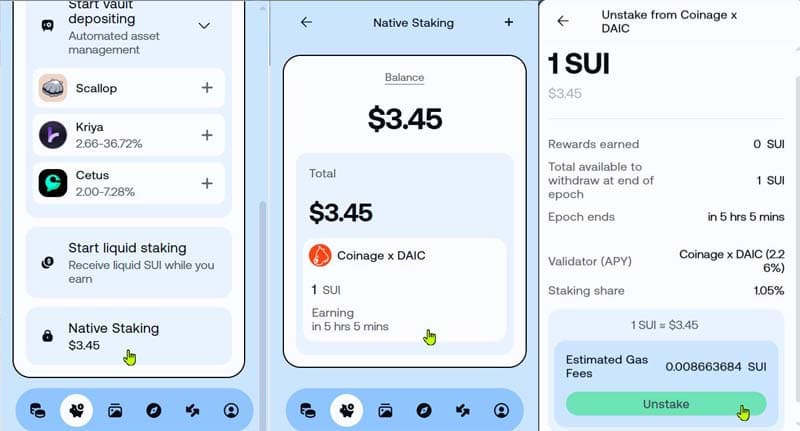
This summary page shows all the important details: the amount of SUI being unstaked, any rewards you've earned, and the time remaining in the current epoch before your SUI becomes available. At the bottom, you'll also see the estimated gas fee before finalizing the process with the "Unstake" button.
Sui Slush Wallet Dapps
If you still have some tokens left in your wallet, you can explore the apps that are integrated in Sui Slush Wallet. At the bottom of the window you'll see a panel with tabs, click on the "Apps" tab.

This section is organized with a helpful filtering system at the top, making it easy to browse apps based on their purpose. Under “Finance” you might discover DeFi projects and liquidity protocols like NAVI and Kriya, the “Play” filter can suggest games, and the “Bridge” shows tools like Wormhole Connect for cross-chain activity.
Exchanges and Trading
In addition to the way of buying SUI tokens that we have already explored, you may purchase and exchange them on most popular exchanges - Binance, OKX, HTX, Bybit, KuCoin, Gate.io and other. According to CoinMarketCap, SUI tokens are traded on more than 60 exchanges.
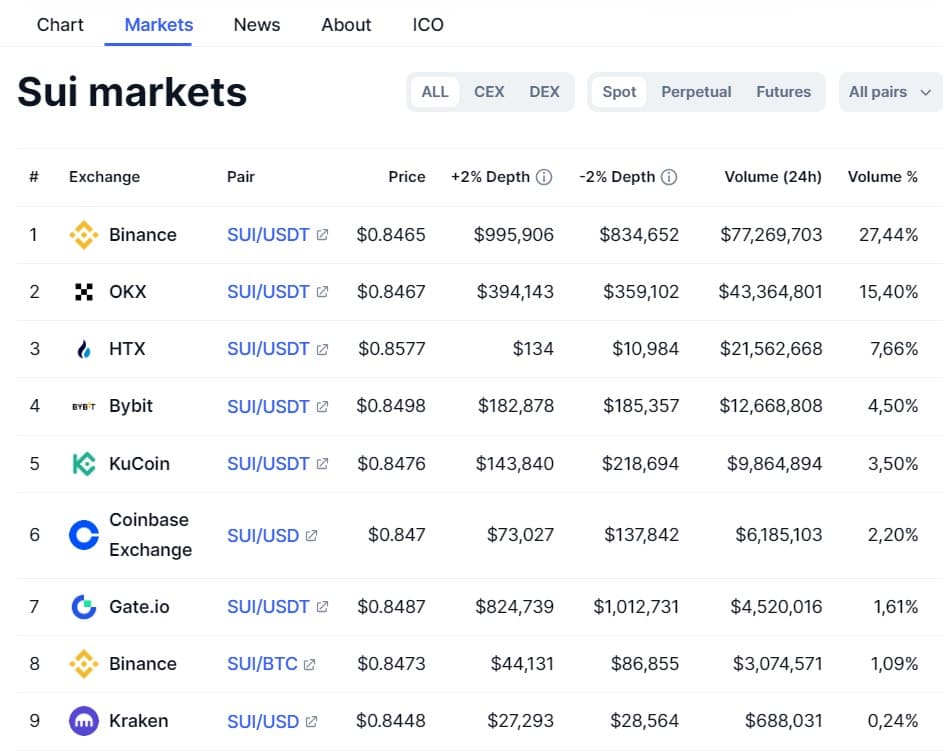
Before choosing an exchange, it is important to do research and compare features, limits, commissions, and supported currencies, as there are significant differences between each of them.
Binance is the largest and most liquid exchange worldwide, offering a wide range of features such as margin trading, crypto futures, staking platforms and NFT features. Kraken, famous for its longevity and security, is suitable for buy-and-hold strategies, but offers slightly higher commissions compared to other platforms. OKX centers on trading cryptocurrency futures, while Bybit has gained popularity among yield enthusiasts. Gate.io serves over 10 million customers in 130+ countries. MEXC stands out with user-friendly features and near 0% commission for spot and futures.
Real-Life Applications of Sui Blockchain
The Sui rapidly becomes an important player in the Web3 landscape, offering a number of practical and new applications across a variety of industries. From the revolution in DeFi via its innovative DEXes and liquid staking protocols to transforming supply chain management, decentralized data storage, and digital identity verification, which push the limits that blockchain technology allows.
The ecosystem continues to grow with great news such as the recent launch of the Sui Bridge, that enabled seamless interoperability with Ethereum and marked significant milestones like the $500 billion in cumulative volume by DeepBook, the native liquidity layer. Sui combines powers in both areas of technical innovation and UX, hence providing a force of momentum to the continuous Web3 revolution.
Gaming Industry
SUI is rapidly gaining ground in the gaming industry, with its innovative "object-oriented" model, which is highly suitable for game development and in-game object creation.
This approach is useful for game developers on engines like Unity or Unreal Engine 5, as it allows seamless advancement of in-game NFT assets and improves the overall players’ experience. In addition, Sui offers a sponsored transactions feature that removes the burden of gas fees from users and the ability to integrate zkLogin, allowing secure authorization with no need for private keys or seed-phrases.

The Sui gaming ecosystem is growing rapidly, offering more than 40 games, with many more to come. Moreover, Mysten Labs actively fosters this growth through initiatives like the Play Beyond gaming portal, equipping both players and developers with a one-stop-shop opportunity for immersive gameplay and building. Play Beyond is a showcase of the breadth of games on Sui, a valuable resource for developers looking to build blockchain games, and a strong community of Web3 gamers.
Popular Games Driving Adoption
A diversity of engaging games are already live on Sui, including:
- Panzerdogs: A team-based multiplayer tank brawler where players design and customize their tanks to compete in deathmatches. In Panzerdogs, the game assets like tanks and avatars are secured and traded on the Sui network, adding ownership and value to this play-to-earn experience.
- Bushi: This is an action-adventure set in a fantasy world inspired by ancient Japanese culture, whereby the player takes on the role of a skilled samurai who embarks on a quest of constant battling and decision-making processes that influence the storyline.
- Cosmocadia: This fantasy game lets to create the own island and build it up by collecting NFTs, which are applied in unlocking unique characters, resources, and special in-game advantages.
- DoubleUp: A platform that includes various casino games: Blackjack, Roulette, and Plinko. It also integrates a lottery system and a token creation tool, proving the power of Sui in various gaming use cases.
- XOCIETY: A community-driven world powered by Sui's NFTs and fast transaction speed for the most immersive and engaging gaming experience. It's all about user-generated content with active community building and shaping up the future of a player's gaming world.
The soon-to-arrive SuiPlay0x1 handheld gaming device for Sui games is poised to fill the gap between traditional and blockchain gaming, making Web3 far more accessible for larger numbers of gamers. With native support for Sui games along with Steam and Epic game libraries, SuiPlay0X1 ushers in a new era of gaming, combining the excitement of gameplay and new features around digital assets enabled by blockchain technology.
With its scalable network and industry leading transaction speeds, Sui realizes the promise of Web3 gaming, where players gain a highly personalized experience through their owned digital assets. Rather than game makers needing to build in-game markets, Sui natively supports tradable assets with a high degree of customization available. Unlike other blockchains, Sui's object data structure supports in-game items that players can easily personalize and swap.
NFT Landscape
NFT collections play an important role in the Sui ecosystem, bringing excitement and intrigue to the community and opening up a wide range of opportunities for collectors and investors.
For instance, recently, Formula 1 racing team Oracle Red Bull released a collection of digital collectibles on Sui network for its fans in celebration of a strong showing in the 2023 season.

Maintaining the NFT trend, Sui offers an entire infrastructure for creators, collectors, and investors, enabling them to interact with NFT on many levels. From art and digital fashion to immersive gaming, these platforms demonstrate Sui's versatility in supporting creative endeavors.

Speaking about the technical side of Sui, the hybrid consensus approach enables the Sui network to handle increased loads and high demand easily during NFT token minting, while Solana and Ethereum encountered network problems.
Transactions like NFT mass minting are separated from transactions related to DeFi activity. They bypass consensus, freeing up validator resources for DeFi, providing a stable environment for processing DeFi transactions.

Sui is a powerhouse that empowers artists and communities with ease to rise in the space of NFTs.
Transforming Industries and Reimagining Experiences
- Studio Mirai: Through the dynamic functionality of NFTs and blockchain tooling, Studio Mirai enables new ways to express creativity and interact with fans that bring creators closer to their audiences and unlock new revenue streams.
- Sui Generis: This leading NFT auction house migrated to Sui for its state-of-the-art technology and its active community. It provides a curated platform for established and emerging artists alike to present and auction their work.
- Quantum Temple: This innovative startup rethinks travel as an industry, using Sui's dynamic NFTs to create authentic, immersive travel experiences that impact the livelihood of local communities and promote sustainable tourism.
- DeLorean Labs: In a revolutionary way, DeLorean Labs is tapping into Sui's NFTs for representation of build slots for the new DeLorean electric vehicle, granting owners verifiable ownership and exclusive access to digital experiences in the Motorverse. The new direction is working out, blending tangible and digital worlds, as it showcases just what can be done with NFTs toward reshaping ownership and engagement in the automotive industry.
- ONE Championship: Leading global martial arts organization aims to take advantage of Sui’s onboarding tools such as the Sui's zkLogin and integrate Web3 experiences seamlessly into its fan engagement strategy. ONE Championship is creating an immersive manga series with its athletes, free-to-play game, allowing fans to create immersive experiences that include rewards and collectibles in return.
- Sui Nami Bags: These digital gift bags were a perfect representation of what Sui's NFTs can deliver on brand activation and audience engagement. At Sui Basecamp, with the distribution of NFTs and coupons to all its attendees, Sui could show and tell how easy it is to use their NFT technology in creating unique and memorable experiences.
DeFi Market
DeFi services within the Sui ecosystem utilize the network's distinctive transaction processing model, allowing for higher throughput compared to other blockchains. This means more DeFi activity per second, with faster transaction finalization, minimizing the risk of delays for users in volatile markets.
Sui's commitment to low and predictable gas fees ensures cost-effectiveness for each DeFi transaction, setting it apart from other chains.
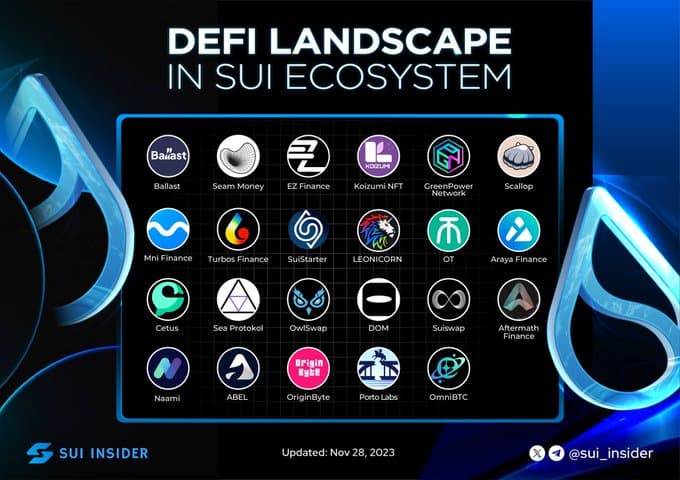
For now, Sui hosts over 20 DeFi protocols, encompassing decentralized exchanges (DEXes) and lending services, with many featured on DeFi Llama.
DEXes: The Force Behind Decentralized Trading
Sui hosts a diverse array of the most influential DEXes with special features and competitive edges, among which are, but not limited to, the following:
- Cetus: An early mover DEX that packs a concentrated liquidity protocol and an intuitive DCA tool for automated investments.
- Aftermath: A fully on-chain DEX that promises seamless, trustless centralized exchange experiences for spot, perpetuals, money markets, and liquid staking.
- KriyaDEX: Deep liquidity, unique trading pairs, and a professional trading terminal with limit orders are provided, along with pioneering cross-protocol strategy vaults.
- Turbos: Unlocks Sui's powerful object-based design for optimized smart routing and automated vaults for liquidity providers, maximizing yields while simplifying the approach to DeFi.
- FlowX: A multi-functional platform for trading, farming, and launching a project, all put together in such a way as to provide the user with a seamless and intuitive user experience.

Liquid Staking Solutions
By supporting liquid staking protocols, Sui enables users to stake their SUI tokens while staying liquid for other on-chain DeFi activities.
- Haedal: The largest liquid staking protocol on Sui, offering haSUI - a very liquid and highly integrated staking derivative. During Q3, the TVL on Haedal has more than doubled, successfully surpassing $80 million. Haedal currently constitutes the largest liquid staking protocol on the Sui ecosystem in terms of TVL.
- Volo: Provides vSUI - another liquid staking solution to unlock the full utility of your staked SUI.
- Aftermath: Provides liquid staking, among other DeFi services, making it a one-stop shop for several financial needs.
Lending and Borrowing
The Sui lending platforms give a broad option to their users through which one can borrow or lend assets at competitive interest rates.
- Scallop is a next-generation money market with an institutional-grade lending model featuring more composability and security. In Q3, Scallop reached an essential milestone of over $100 billion in total lending and borrowing volume.
- NAVI is the largest lending protocol on Sui. At the middle of September, NAVI launched one of the most expected features for the freshly released NAVI Pro dApp - Leveraged Strategies. With this feature, leverage strategies are democratized for each and every NAVI user in just one click.
- Suilend is the fastest-growing lending protocol on Sui from the creators of Solend, one of the most popular DeFi lending protocols on the Solana blockchain. Many years of experience at treading ups and downs in the harshest crypto markets have cultivated Suilend's risk management to be best in class.
Exploring New Horizons in DeFi
Besides conventional services, Sui's DeFi ecosystem incorporates innovative solutions, such as:
- Collateralized Debt Positions: The Bucket Protocol allows the borrowing of yield-bearing tokens, and generate stablecoins with CDPs.
- Derivatives: The possibility of trading sophisticated derivatives like options and futures is opened for the advanced trader by BlueFin and Typus Finance.
- Yield Optimizers: AlphaFi and DoubleUp create new ways and possibilities in yield maximization on different DeFi protocols.
While Sui has gained a lot of attention with its lucrative DeFi ecosystem, its potential extends far beyond decentralized finance. Its unique architecture and technical capabilities are being leveraged to introduce revolutionary changes in a wide range of industries and applications.
Sui Use Cases Beyond DeFi
Sui is proving to be highly versatile with an already growing number of real-world applications:
- Environmental Sustainability: Sui is being applied to solve real-life problems such as carbon emission. In partnership with Fils, Sui's blockchain is used for tracking and verification of the carbon credits in order to bring more transparency and accountability into environmental pursuits.
- Telecommunications: Karrier One uses Sui to build a decentralized wireless phone service that showcases the potential of blockchain technology in changing traditional telecommunication infrastructures.
- Collectibles Authentication: AGSpeedy utilizes Sui to securely and transparently grade and certificate collectibles. AGSpeedy stores authentication certificates on the Sui blockchain, thus guaranteeing ownership and provenance, hence increasing trust and security for all participants.
- 3D Printing and Manufacturing: 3DOS is a leading innovator of 3D printing, connecting its huge network with Sui for the creation of a global, decentralized platform of users, printers, and manufacturers to provide the foundation for collaboration, access, and innovation in manufacturing.
- Internet of Things: Chirp collaborates with Sui to create a decentralized network for IoT devices. High throughput, combined with low latency, forms the basis on which Sui empowers Chirp to securely and efficiently collect data from millions of devices, which enables new capabilities in smart homes, cities, and industries.
Various blockchain use cases developed on Sui prove the latter's potentiality to change many aspects in a wide range of spheres and further solidify its status as one of the game-changing Web3 drivers.
A Thriving Developer Community
Sui has the largest and the fastest-growing Move developer community. In fact, the total number of full-time developers building on Sui has increased consecutively at a rate of over 145% month over month. Moreover, the number of new developers-starting with part-time and first-time developers, growing more than two times in just three months-shows great developer momentum that indicates immense interest in building on Sui.
Seamless Development Tools and Resources
Sui is built to make development as seamless and effective as possible, and offers a suite of tools and resources for that purpose.
- Debugging with Sentio: Sentio's Dash and Debugger tools provide critical insights and debugging for the developer, improving overall developer experience and ensuring the quality of Sui apps.
- Amazon AWS Node Runners: Amazon's AWS now natively supports Sui through Node Runners. The Node Runners make deploying and managing Sui nodes easier on the powerful AWS cloud infrastructure.
- BytePlus Integration: BytePlus, a subsidiary of ByteDance, is contributing to the Sui ecosystem in terms of AR technology, Content Delivery, and User Engagement. With BytePlus, developers can build personalized, engaging applications that have worldwide impact.
- Birdeye Data Services: Birdeye provides deep access to crypto market data APIs and WebSockets, which empowers developers to build data-driven applications including but not limited to DEXes, wallets, and trading bots.
- Atoma AI Inference Network: Atoma has been working on integrating its AI inference network with Sui, which could allow developers to easily bring in AI into their applications. This opens up more avenues for intelligent decision-making and automation within decentralized applications.
- Tencent Cloud Blockchain RPC Service: Tencent Cloud's high-throughput RPC service now supports Sui, giving developers an extremely scalable and reliable infrastructure for their Web3 applications.
- Hop Aggregator SDK and API: Hop Aggregator provides an extremely developer-friendly swap SDK and price API to make seamless integration of decentralized exchange functionality into Sui applications.
- Stardust Web3 Gaming Services: Stardust offers a suite of services for Web3 game developers, from wallets-as-a-service to user acquisition tools, that make onboarding seamless and enhance player engagement.
- Overmind Developer Platform: A set of interactive, gamified quests from Overmind makes it fun to learn Move and start building on Sui.
- EasyA Education Platform: EasyA's educational modules and coding challenges walk developers through Sui and other blockchains in depth, helping to shape a new generation of Web3 developers.
The commitment of Sui to supporting developers, coupled with its high-performance blockchain and user experience-focused design, forms the perfect combination whereby innovation and growth are able to thrive.
Conclusion
Having walked with you through a detailed exploration of Sui as a technology and platform, we can now conclude that the project is at the forefront of Web3, bringing innovations that have the potential to transform the decentralized landscape.
It’s worth noting that other projects are not behind the scene. Their solutions may not be perfect and may look outdated, but in such diversity new ideas arise, and therefore it is a reason to always keep an eye on them.
The information provided by DAIC, including but not limited to research, analysis, data, or other content, is offered solely for informational purposes and does not constitute investment advice, financial advice, trading advice, or any other type of advice. DAIC does not recommend the purchase, sale, or holding of any cryptocurrency or other investment.


